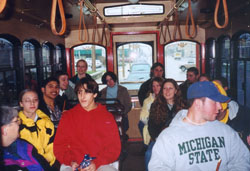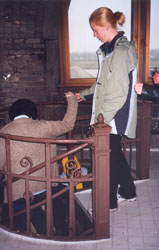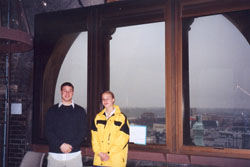
Home
- Artifacts
- Buildings & Businesses
- Churches
- Holidays & Celebrations
- Counties/Locations
- Delta College
- Early Settlers
- Ethnic Background
- Local, Michigan, U.S. and World Events
- Family Genealogy
- Farming
- Libraries & Museums
- Local Sites
- Logging
- Musicians, Artists & Famous People
- Nature, Weather & Four Seasons
- Railroads
- Schools
- Sports
Recollections of Our Past
The small, rectangular, two-story brick building nestled next to the Clock Tower on Washington Avenue proudly displays an American Flag and eagerly awaits visitors who will comb through her exhibits. It is here, at the Bay City Historical Museum, that reminders of Bay City's history and origins are proudly displayed for everyone to view--from the young and innocent to the old and experienced. It is also here that we gain knowledge about the past and share with others the importance of our heritage and how it has shaped our future and community.
 |
| English 111A Students Ride Trolley to Museum |
To learn more about the Bay City Historical Museum, I climb the damp red cement stairs that lead toward its double glass-plated doors. I quickly cross my arms, as if hugging myself, while the cold March wind nips at my body, causing me to shiver and quicken my steps. Once inside, warm air hits my cheeks, causing my face to flush and my eyes to moisten. As I look around I notice a gift shop to the right and a small library to the left. However, my real destination is upstairs. I proceed to a cherry-stained staircase, where I place my hand upon a smooth banister and ascend to the second floor, wondering what lies ahead. As I turn slightly to the right through the doorway, I have a choice of proceeding straight ahead or going left down the main hallway. I choose to go straight.
My boots scuff across the shiny laminate floor as I proceed down the narrow hallway. I then come to a display at the end. Standing at the end of the hallway, I notice plaques that grace the wall and tell a story of a place in time long ago. My attention is diverted away from the plaques when I peer past my reflection through the light reflective glass window to a display of a turn-of-the-century bank. A long wooden counter with vertical black bars and a carefully placed shiny silver bell at the left corner sternly sits. In the left hand corner there silently rests a safe that is slightly aged with its eroding paint and worn away edges.
 |
I walk back to the main exhibits where I view more displays of late eighteenth and early nineteenth-century nostalgia. A child's room equipped with toys and dolls appears before my eyes. Teddy bears, hairbrushes, and instruments are carefully placed about the room. The only thing missing is the children, although I can imagine the bubbles of laughter that would have resounded throughout the room. Behind me is a display of a woman's clothing and the types of materials and fabric a lady would have carefully selected to stitch herself a fancy dress to complement her figure and complexion. Delicate lace lies flatly on a shelf while a creamy ivory dress sits nonchalantly atop a mannequin
.
The next display is that of late eighteenth-early nineteenth century kitchen, similar to the kind that was probably in everyone's home at one time or another. The entire kitchen is a stark white with elements of color protruding here and there. Fruits such as apples, bananas, and oranges lay on the countertop, waiting to be eaten, while art deco green glass bowls and strategically placed tins sit aside one another.
Next, I step into the large opening of the Kantzler Maritime Gallery, located in the back section of the second floor, where a large blue board with a geographical representation of Michigan is neatly hung on the wall. I step down the carpeted stairs and turn to the right, where my eyes are instantly drawn to a skillfully-assembled miniature lighthouse with illuminated windows. This lighthouse is very significant to Bay City's maritime history in that it helped guide ships to and from shore. Aged black and white photographs sit upon the wall peering back at me with neatly worded text below them to supply people like me with information. Further down sits a dark brown, weathered, hand-carved canoe, about six feet in length. I imagine that an incredible amount of work was put forth to create such a project.
Forging ahead I come to another section in the gallery that displays pictures of shipping vessels and the Bay City crews who worked on them. Ignoring the other items, I am curiously attracted to the paintings displayed upon the wall. Two massive paintings encased in wooden frames are of ships that once sailed the waters of Bay City's harbor long ago. Each delicate brush stroke reveals distinct characteristics of each vessel, showing the relationship between artist and muse.
Behind a clear plastic encasement lies an open, slightly blue-gray, weathered log book with yellowed papered scribbled with black ink, telling of a typical day onboard: "July, Speed eight knots...review recognition signal procedure, be sure you have a man present on the bridge at all times who can answer a challenge. Call the captain immediately if an incorrect challenge is given."'
In another display, a large white board labeled with all sorts of news clippings about Defoe and his ship building company yard grace the walls. Established in 1905, Defoe built ships such as super freighters for the U.S. Army, Navy, and Coast Guard more than any other yard on the Great Lakes. Also, in the late 1960's, Defoe built two oceanographic research vessels and two medium surveying vessels for the U.S. Navy. The RIV Meliville AGOR-14 and the R/V KNORR AGOR-15 were both 244.10' vessels built in 1968 and delivered between 1969 and 1970. The R/V KNORR is famous for helping locate the wreckage of the famous ship disaster Titanic.
 |
Upon leaving the Bay City Historical Museum, I reflect on what I have learned so far. Before I visited the museum, I was clueless about Bay City's past, but now I realize just how important Bay City's history is, especially its maritime history. A lot of people may think of their community as a boring place, but if we challenge ourselves to learn more about our community and its origins and how it came to be, we just might find the story to be interesting. That is what history is--a simple story, and with museums like that of Bay City Historical Museum, we help preserve that story for those who have not heard it.
| The written and visual works in Mid-Michigan Remembers-Stories about Us were chosen on the basis of their quality, diversity, community interest and appeal. Views expressed do not necessarily reflect those of the College. This space is provided as a service by Delta College. |